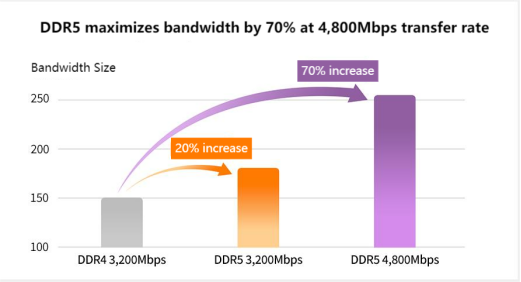
On September 14th, SK Hynix and Intel Corporation jointly announced the release of a comprehensive whitepaper. This whitepaper validates that SK Hynix DDR5 server DRAM, when coupled with Intel CPUs, attains industry-leading performance benchmarks. The whitepaper was made accessible on the official websites of SK Hynix and Intel simultaneously.
From the inception of DDR5 DRAM development, these two renowned entities have fostered a close collaborative relationship. The whitepaper meticulously elucidates the findings gleaned from an intensive eight-month performance verification initiative, employing the 4th Generation Intel® Xeon® Scalable Processor (referred to as the 4th Gen Xeon Processor) in conjunction with DDR5 DRAM.
In recent years, the server industry's surging demand for low-power, high-performance semiconductors is unmistakable. The whitepaper underscores the mission of these two conglomerates—to usher in a new epoch of data centers by providing storage solutions and CPUs that excel not only in performance but also energy efficiency.
The whitepaper spotlights that the 4th Gen Xeon Processor has exhibited a remarkable 2.9-fold enhancement in performance over its predecessor. Furthermore, SK Hynix DDR5 DRAM boasts a 14.4% reduction in power consumption when contrasted with DDR4 DRAM. Notably, the efficiency-power ratio, in the context of servers equipped with the 4th Gen Xeon Processor, reveals a 1.22-fold improvement for integer calculations and a 1.11-fold enhancement for floating-point calculations when comparing DDR5 and DDR4.
Hence, both organizations prognosticate that the prospective utilization of the 4th Gen Xeon Processor and DDR5 in data centers will significantly contribute to augmented energy efficiency and the establishment of sustainable data centers. Furthermore, the optimization of data center operations is projected to result in a discernible reduction in the total cost of ownership (TCO) for clientele.
Mr. Yoo Sung-Chul, Vice President of SK Hynix's DRAM Product Planning, articulates, "As demonstrated in the whitepaper, servers equipped with Intel CPUs and SK Hynix DDR5 DRAM exhibit swifter data processing and diminished power consumption compared to their predecessors. This is especially advantageous in applications necessitating the handling of copious data, such as Generative AI."
Dr. Dimitrios Ziakas, Vice President of Memory and IO Technology at Intel, adds, "Intel has maintained an enduring partnership with SK Hynix and other industry leaders to optimize DDR5's performance in tandem with the 4th Gen Intel Xeon Scalable Processor. These collective endeavors are designed to furnish potent data center solutions that seamlessly combine outstanding performance with energy efficiency for the benefit of our mutual clientele."
SK Hynix is poised to fortify its product portfolio in the server market through this recent collaboration with Intel. Anticipating an upswing in DRAM demand in the latter half of the year, the company intends to bolster its market competitiveness by promoting the 4th Gen (1a) and 5th Gen (1b) DDR5 DRAM as core offerings, thereby expediting performance enhancements.
The whitepaper encompasses comprehensive test data that can serve as a valuable reference for server clients utilizing DDR5 products. It extensively covers aspects such as speed, performance, and power consumption that come to the fore when combining the 4th Gen Xeon Processor with DDR5 memory.
Primarily, under a transfer rate of 3,200Mbps, DDR5 yields a 20% boost in server bandwidth in contrast to DDR4. In fact, at a transfer rate of 4,800Mbps, DDR5 achieves a remarkable 70% surge in server bandwidth compared to DDR4's highest rate of 3,200Mbps. This progress is the outcome of DDR5's improved design structure, which minimizes internal transfer latency and permits higher transfer speeds, thereby amplifying overall server bandwidth.

Additionally, the study conclusively verifies that DDR5 brings about a 14.4% reduction in power consumption compared to DDR4. High-K Metal Gate (HKMG) and other advanced technologies played a pivotal role in this process. HKMG, adopted in the insulating film of the DRAM transistor, not only prevents leakage but also enhances capacitance through a new-generation process. Memory devices incorporating this technology exhibit heightened power efficiency.

The research findings further highlight the outstanding performance of the built-in accelerators within the 4th Gen Xeon Processor. When businesses harness these integrated accelerators to tackle specific workloads, the performance per watt surges by 2.9 times compared to the previous iteration. Through the judicious application of these technologies, the 4th Gen Xeon Processor and DDR5 achieve an impressive efficiency-power ratio, augmenting server bandwidth by 50% while concurrently reducing power consumption by 14.4%.
By releasing this whitepaper, the performance of systems featuring the 4th Gen Xeon Processor and DDR5 is comprehensively validated. Both entities conducted performance comparisons using the "SPEC CPU 2017" system testing tool. The results unequivocally indicate that, in contrast to the prior generation, integer and floating-point calculations experienced enhancements of 1.59 times and 1.43 times, respectively. System performance per unit of power consumption is equally remarkable, with integer and floating-point calculations escalating by 1.22 times and 1.11 times, respectively.
Moreover, in latency and speed tests employing "Intel MLC (Intel Memory Latency Checker)," system performance shines brightly, with read and write performance witnessing notable improvements of 1.4 times and 1.51 times, respectively.




